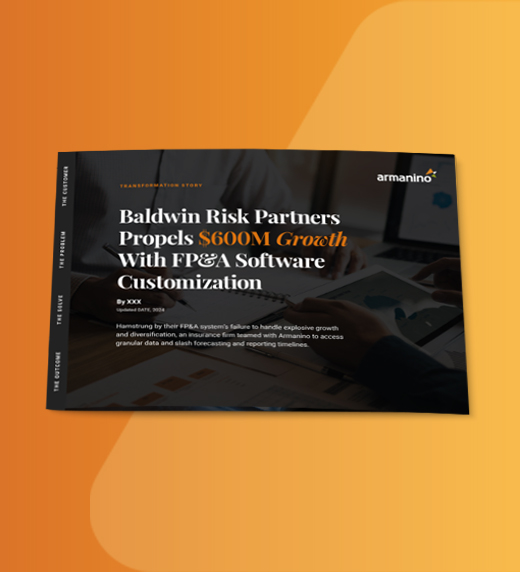Many finance teams, and employees in general, do their jobs using the tools and processes that they’ve been trained on and are accustomed to. But as finance best practices change and technological innovations create new opportunities, relying on the traditional way of doing things can hinder your ability to stay competitive and negatively impact your organization’s bottom line.
You can clearly see these challenges in real life when looking at many companies’ financial planning and analysis (FP&A) functions. Often, finance teams at all sizes of companies operate using manual processes, email and Excel as the single source of truth for their data.
If this sounds like your organization, you’re probably falling victim to four key pitfalls in your planning process that can reduce the effectiveness of your finance team.
- Going It Alone
Many organizations that manually draft budgets leave the entire process to the finance team, which limits other departments’ visibility into their own allotments.
Working with outdated numbers developed without collaboration between teams can result in tension. All stakeholders have difficulty trusting the accuracy of the numbers. Moreover, a team who goes over budget in one quarter is less likely to own its numbers when it didn’t have input into the creation of that figure in the first place. Having cross-departmental contributions is key to getting teams aligned behind targets and holding business owners accountable.
- Being Exactly Wrong
You also should prioritize your costs. Finance teams frequently spend unnecessary energy planning where every penny will be spent. The reality is company leadership is focused on revenue and expenses at a macro-level and manages revenue and expenses based on major drivers, such as average sales price/deal size, number of employees, salary increase rates and capital purchases.
It’s better to be approximately correct than exactly wrong. Identify the costs that really matter to your business and set the direction to hit those numbers with the understanding that the budget is materially close to expectations.
An example of this is Federal Unemployment Tax Act (FUTA) costs. Any precise budget for FUTA costs will probably be inaccurate because you can’t predict the exact amount of employee turnover. Instead, consider applying a historically accurate tax rate that is highest in January and lowest in December. This way, you’ll temper expectations but still be in an approximate range that doesn’t lead to downstream effects on the rest of your financial plans.
- Refusing to Break Up With Excel
Excel is an incredibly useful tool. User adoption is relatively straightforward, and as your organization begins to expand, adding tabs for new departments or locations is simple. But the solution has its limits. When multiple people use it for reporting and forecasting, precious time is wasted poring through emails to make sure you capture the latest version, that it incorporates every update, or that it reflects current initiatives.
Plus, there is the risk of human error, and the mistakes made by organizations that rely on Excel for planning are legendary. In 2012, for example, Utah’s state education budget saw a $25 million shortfall due to a reference error in an Excel formula. Two years later, a similar spreadsheet error cost Tibco shareholders $100 million.
There are also the operational challenges your finance team endures when planning solely through spreadsheets. You likely have some highly educated and motivated MBAs who are tasked with shoveling through emails and reconciling spreadsheets. And often, the day before a board meeting, the CFO is asked to revise some estimates and the finance team may have to work through the night to prepare numbers. The CFO often is not confident in the numbers they present because of concerns that the updates didn’t propagate through all of their reported results.
This is an ineffective use of highly skilled employees that could eventually lead to their exit, costing your organization lower morale and ramp-up time associated with attrition, while still leaving you coping with the excel accuracy risk organization-wide.
- So-and-So Knows Best
Resistance to change commonly holds back companies’ planning functions. As mentioned earlier, we’re creatures of habit and generally don’t veer from the methodologies we’re used to. Financial analysts also tend to defer to finance leaders who may not be up to date on the latest tools available to them.
For your organization to be competitive, you need to have the people, processes and technology that can scale with you. Investing in improvements to your FP&A functions may seem risky at first. But given the potential consequences of not upgrading these functions, it may make sense for your organization to rethink its approach.
Next Steps
Addressing shortcomings in your financial planning should be tackled holistically by your organization, with the finance team a key strategic partner. But before you make changes, carefully break down your budgeting, forecasting and reporting needs. Collaborate with those who execute plans, resource managers and the executive team to vet out your top priorities.
Then you can begin to evaluate tools. You may realize that Excel is still a viable solution but just needs reformatting to scale with your planning goals. If it’s not, there are myriad FP&A software solutions that align with different priorities.
Moving up to a full-scale FP&A solution is an investment that shouldn’t be taken lightly. However, implementing a planning tool that fits your organization can lead to cost savings, reduced risks and empowered strategic decision-making.
If you need help demystifying the array of FP&A software solutions, contact our experts.



